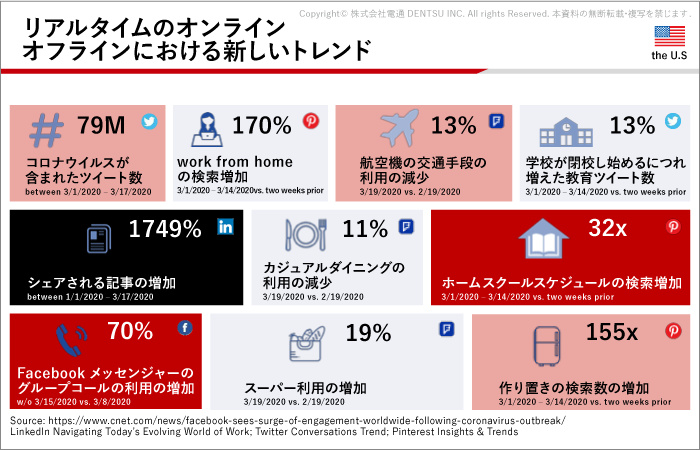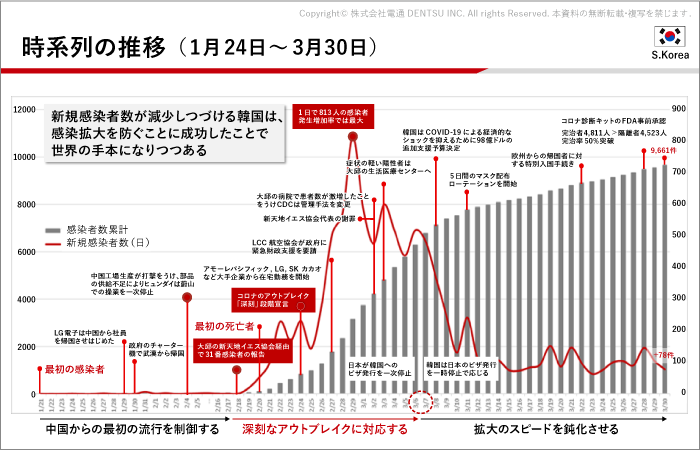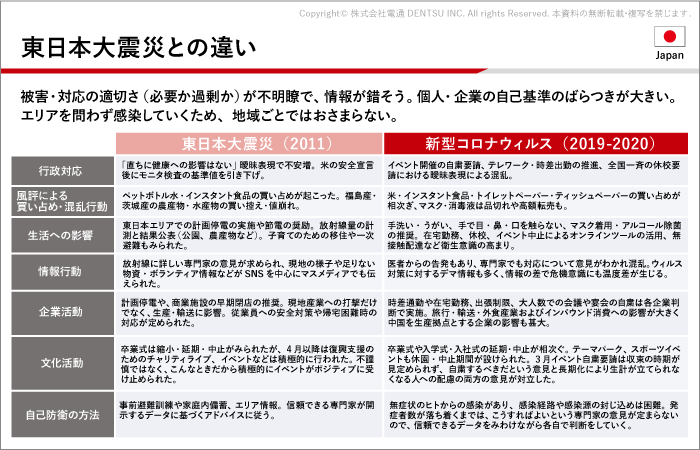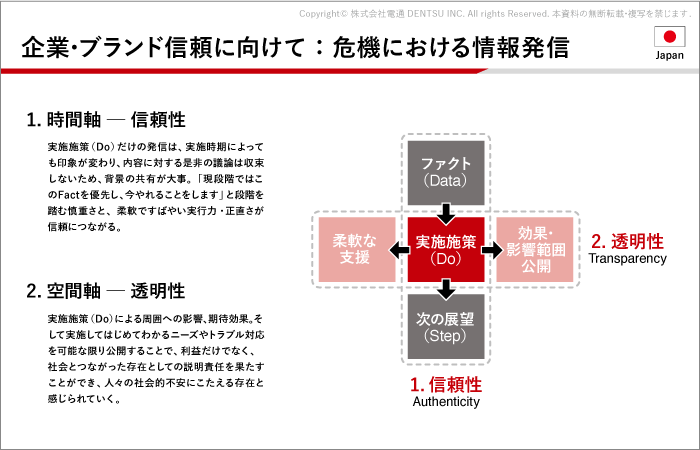At a time when "staying safe" is paramount, we learn from around the world what companies can do.
In April 2020, 3.9 billion people—half the world's population—experienced lockdown restrictions. In Japan, terms like "social distancing" and "telework" became commonplace, and news reports and social media posts increasingly featured overseas developments.
However, news alone cannot reveal how daily life and business actually functioned overseas. Here, we compile reports from Dentsu Inc. Aegis Network's 300 global locations, compare the impacts of the February-March lockdowns across regions, and explore what kind of information companies should communicate during crises.
What did unprecedented movement restrictions bring? Asia became the compass for the world in February and March
As early as mid-February, Dentsu Inc. Aegis Network was already releasing reports from Taiwan, China, and Singapore on brand case studies responding to the crisis and its impact on business. This was because the business impact of the novel coronavirus outbreak showed similarities to the SARS outbreak in Asia in 2002, suggesting proactive measures could be taken.
Indeed, post-SARS Asia saw significant damage to tourism and manufacturing, while healthcare, e-commerce, telework, and home entertainment industries benefited. This catalyzed the explosive growth of e-commerce and online services that later underpinned China's development. It demonstrated how shifts in lifestyle create business opportunities.
(Note: As of April, efforts to prepare for the long term are intensifying, drawing lessons from the Spanish Flu—which spread globally over multiple waves—rather than SARS, which was short-lived and confined to Asia.)

In China, February's movement restrictions heightened demand for "O2O (Online to Offline)", "online education platforms", and "health-conscious lifestyles at home". There was also a surge in "instant, accurate information access" to avoid isolation and "community activities fostering social connection and empathy". These phenomena were observed globally the following month in March. Reports from Europe and the US cited insights from various Asian regions during February, with similar phenomena confirmed by data.

Taiwan implemented its "epidemic prevention campaign," drawing on lessons from SARS, while South Korea adopted its "three policies" (1: information disclosure, 2: transparency, 3: democratic process), based on lessons from MERS (Middle East Respiratory Syndrome), from the very early stages of the novel coronavirus outbreak. Both systems aimed to prevent public confusion by consolidating the views of multiple government agencies and collaborating with local governments and private companies to swiftly deliver accurate information. Both South Korea and Taiwan rigorously implemented daily government press conferences, proactive social media dissemination of official information, public disclosure of infection routes in coordination with local governments, and clear guidance on where citizens should go for inquiries or testing.
While learning from the world is important, conditions naturally vary by region, so the final course must be determined locally based on the situation. However, information from other regions and lessons from the past, even if they don't provide an exact map, can serve as a compass to help determine direction.
When there is no single correct answer—whether the trajectory will mirror other regions or, if divergent, what variables might cause it—comparison provides clues for action. Particularly in this crisis, with spatial and temporal lags between Asia and the rest of the world, and the need to prepare for second and third waves in a protracted battle, Asia is likely to remain a closely watched leading example for the world.

How do social movements emerge during times of chaos?
During Italy's nationwide lockdown, videos and news reports showed residents singing from their windows. While the situation remains heartbreakingly severe, these window-singing scenes might have conveyed an image of people finding brightness and unity—like Japan's "home drinking" trend—holding onto hope with a glass of wine in hand.
However, in the early days of Italy's lockdown, supermarkets had entry restrictions. Purchasing essentials like flour, pasta, rice, oil, and seasonings took priority, while non-essential items like wine, beer, and snacks were put on hold. Brand advertisements at the time also prominently featured serious messages like "Now is the time to endure."
Later, what truly moved people's hearts toward quarantine more than the lockdown itself was the #iorestoacasa (I'm staying home) declaration. Influencers appealed, "For the sake of our grandparents, don't visit them." Once this hashtag emerged, recipe searches surged, interest in DIY grew, and people finally resolved to actively embrace staying home. From late March, Click & Collect users more than doubled. Advertising also increasingly featured ways to enjoy time at home and expressions of gratitude to supply chain workers, moving beyond just restrictions on going out. Thus, during Italy's lockdown, there were distinct stages as people adapted to the crisis, with attitudes and behaviors gradually aligning.

In contrast, China saw positive messages like "加油" (Jia you, meaning "Let's do our best") quickly accepted in both advertising and social media right from the start of its initial lockdown. In Taiwan, government "epidemic prevention campaigns" featured not only doctors and politicians but also actors and influencers. Local government accounts posted humorous content inspired by popular dramas and idols, avoiding an overly serious tone and instead using humor to engage people and get them to pay attention to the information.
In South Korea, Asan City, which became the quarantine and reception site for people returning from Wuhan on a chartered flight, faced reports claiming "citizens are opposed." To convey that this was not the sentiment of all residents, citizens voluntarily used the hashtag "#Weareasan" to send warm messages to those in quarantine.

Right: Hashtag conveying messages from Asan citizens (South Korea)
The difference in how quickly social movements emerged in Italy versus China, Taiwan, and South Korea likely isn't due to infection numbers or inherent national character. It probably stems from differing tolerance for information between a stage where people are accustomed to emergencies and know "what to do," and a stage of unprepared anxiety. In China, Taiwan, and South Korea, memories of SARS and MERS were still fresh, government responses were swift, and people understood their responsibilities.
Looking at Japan, until mid-March, there was uncertainty about the correct course of action and a general distrust of information. However, by the time the state of emergency was finally declared, people had become somewhat accustomed to both the situation and the information. Then, around the end of March, messages urging people to "stay home" began spreading rapidly, coming from YouTubers, athletes, celebrities, and others. This finally led to a shared understanding: staying home wasn't just about obeying warnings from the government and experts, but that "staying home is the social contribution each individual can make." People started to receive and appreciate positive messages from companies, like "Let's get through this together" and "Let's show our gratitude to healthcare workers."
During the next holiday period, the greatest contribution to healthcare workers will be not just avoiding the three Cs (closed spaces, crowded places, close-contact settings), but strictly maintaining physical distance. To prevent people from growing weary of the warnings, it is now even more crucial to continuously communicate the "necessary actions" using varied expressions.
In fact, during the Great East Japan Earthquake, there was also panic buying and questioning of information accuracy. Once the information cycle stabilized, a movement emerged to support reconstruction together. However, even knowing that a call to "unite and fight" would eventually come, it's not simply a matter of delivering the message quickly. As seen earlier with Italy, a "digestion period" was necessary – a time to process vast amounts of diverse information – before people could truly internalize it as something personally relevant.

What we can learn from other Asian examples is the importance of "releasing a large volume of official information early and within a short period, showing what actions lead to what consequences, and preventing panic" before companies issue messages to boost morale. Only after both the government delivers serious messages and opinion leaders consistently communicate, not criticism but positive guidance on what each individual should do, can people finally receive and accept positive messages from companies. There still seems to be much to learn from overseas regarding phased information dissemination during panic situations.

The presence or absence of a brand purpose directly impacts initial response in crises and long-term fanbase acquisition
What set brands apart in their swift initial responses during this crisis? Of course, online service providers were active with social contribution activities and messages. But for other thriving categories—like skincare products selling due to mask and disinfectant-induced skin irritation—would consumers really want messages solely promoting product efficacy? As Unilever's message across multiple countries and hygiene brands—"It's okay to use other brands, just wash your hands well"—garnered attention, this was a moment when corporate stance resonated more deeply than communicating individual product features.
Furthermore, even in areas where lockdowns didn't directly create new demand, several brands demonstrated a proactive stance, asking "What can we do during this time?" For example, in Japan, Lawson had long embraced the slogan "The Neighborhood Warmth Station," with its commitment to community contribution deeply ingrained throughout its operations. This enabled swift action: immediately responding to the nationwide school closures starting March 2nd by announcing free rice ball distribution for schoolchildren, and offering milk products like café au lait at half price during the closure period to support dairy farmers who could no longer sell milk for school lunches.
Because they maintain the stance that "no matter the circumstances, what the brand values remains unchanged," their messages and actions urging people to "now is the time to do what we can" resonate with empathy and persuasiveness. Whether actions can be taken based on brand purpose, fulfilling the points below, becomes especially clear during crises.
- How does this business/brand exist to contribute to society?
- Is it unique, tied to the business/brand's history, and meeting consumers' current expectations?
- Does it inspire all people involved at every touchpoint?
- Does the business/brand support customers and employees in engaging in social contribution activities?
The new lifestyles rooted by the crisis will accelerate current evolution rather than drastically change its direction. The renewal of customer experiences blending digital and physical, the transformation of company structures like e-commerce and owned media, and the permeation of brand purpose discussed here—these will drive people's social actions, accelerating the power of "WE" rather than "ME."
Was this article helpful?